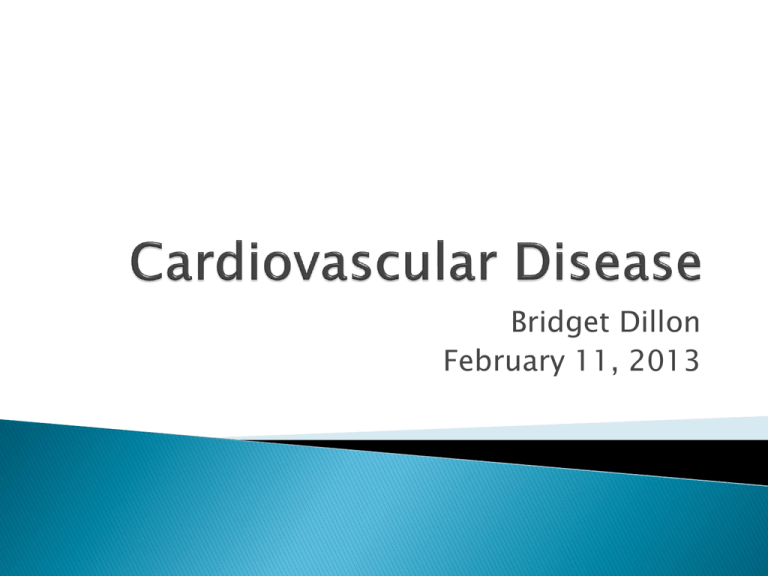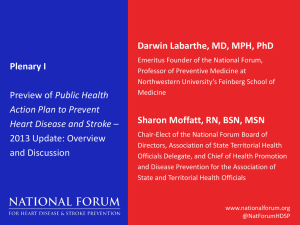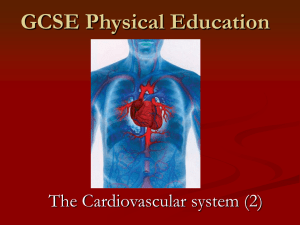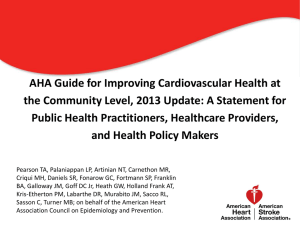
Bridget Dillon
February 11, 2013
Cardiovascular disease affects the heart and
circulatory system. It is often a result of
blockages of blood vessels.
Some examples of Heart Disease are:
◦
◦
◦
◦
◦
Coronary Artery Disease*
Heart Attack*
Stroke*
Rheumatic Heart Disease
Congenital Defects
The American Heart Association has seven
different measurements to determine
cardiovascular health.
There are four health behaviors: smoking, physical
activity, healthy diet and energy balance demonstrated
by healthy weight.
◦ There are three health factors: BP, blood glucose
and blood cholesterol.
Age-standardized prevalence estimates for poor, intermediate, and ideal cardiovascular
health for each of the 7 metrics of cardiovascular health in the American Heart Association
2020 goals, among US adults aged ≥20 years, NHANES 2009-2010
Go A S et al. Circulation 2013;127:e6-e245
Copyright © American Heart Association
Prevalence of stroke by age and sex (National Health and Nutrition Examination Survey:
2007–2010).
Go A S et al. Circulation 2013;127:e6-e245
Copyright © American Heart Association
It is harder to pinpoint actually onset disease,
but continuous monitoring can provide an
estimate.
Often used to indicate first stroke or heart
attack suffered.
Incidence of cardiovascular disease* by age and sex (Framingham Heart Study, 1980–2003).
*Coronary heart disease, heart failure, stroke, or intermittent claudication.
Go A S et al. Circulation 2013;127:e6-e245
Copyright © American Heart Association
Incidence of cardiovascular disease according to the number of ideal health behaviors and
health factors.
Go A S et al. Circulation 2013;127:e6-e245
Copyright © American Heart Association
Annual age-adjusted incidence of first-ever stroke by race.
Go A S et al. Circulation 2013;127:e6-e245
Copyright © American Heart Association
Proportion of patients with recurrent stroke in 5 years after first stroke.
Go A S et al. Circulation 2013;127:e6-e245
Copyright © American Heart Association
In 2008, 17.3 million people died as a result of
CVD (WHO).
◦ 30% of global deaths
◦ 80% of all CVD deaths occur in low and middle income
countries
In the US, heart disease was the leading cause of
death in 2008 (NHLBI).
In 2007, heart disease accounted for 190.1 deaths
per 100,000 (out of 760.2 per 100,000) in the US
◦ Strokes accounted for 42.2 deaths per 100,000.
http://apps.nccd.cdc.gov/DHDSPAtlas/viewer.aspx?state=MI
Cardiovascular diseases are the number one
cause of death globally.
WHO estimates that almost 25 million will die
from CVDs by 2030 (mostly heart attack and
stroke).
7.5 million deaths each year (13% of all
deaths) can be attributed to high blood
pressure including 51% of stroke deaths and
47% due to coronary heart disease)
Overall US death rate attributable to CVD
declined by 37% from 1999 to 2009. (AHA)
◦ It still accounts for 32.3% of all deaths.
In 2009, 34% of deaths attributable to CVD
occurred before age 75
◦ 20% of these (6.8% of total) occur before age 40.
Cardiovascular disease mortality trends for males and females (United States: 1979–2009).
Go A S et al. Circulation 2013;127:e6-e245
Copyright © American Heart Association
Percentage breakdown of deaths attributable to cardiovascular disease (United States: 2009).
Go A S et al. Circulation 2013;127:e6-e245
Copyright © American Heart Association
Age-adjusted death rates for stroke by sex and race/ethnicity, 2009.
Go A S et al. Circulation 2013;127:e6-e245
Copyright © American Heart Association
Proportion of patients dead 1 year after first stroke.
Go A S et al. Circulation 2013;127:e6-e245
Copyright © American Heart Association
Proportion of patients dead within 5 years after first stroke.
Go A S et al. Circulation 2013;127:e6-e245
Copyright © American Heart Association
Risk of CVD is increased by high blood
pressure, poor diet, lack of exercise, and high
cholesterol among other triggers.
◦ Early warning signs of heart attack and stroke are
also not recognized by most of the population
People with diabetes are 2-4 times more
likely to die from heart disease or suffer a
stroke.
Having a heart attack or stroke increases the
chances of a second one.
Genetics
Estimated 10-year coronary heart disease risk in adults 55 years of age according to levels of
various risk factors –(Framingham Heart Study).
Go A S et al. Circulation 2013;127:e6-e245
Copyright © American Heart Association
Estimated 10-year stroke risk in adults 55 to 84 years of age according to levels of various
risk factors (Framingham Heart Study).
Go A S et al. Circulation 2013;127:e6-e245
Copyright © American Heart Association
Coronary Heart Disease alone costs the
United States about $108.9 billion a year.
Stroke costs $54 billion a year.
There are additional costs associated with the
long term disability and therapy to recover
from stroke.
Direct and indirect costs of cardiovascular disease (CVD) and stroke (in billions of dollars),
United States, 2009.
Go A S et al. Circulation 2013;127:e6-e245
Copyright © American Heart Association
Projected total costs of cardiovascular disease (CVD), 2015–2030 (2010 $ in billions) in the
United States.
Go A S et al. Circulation 2013;127:e6-e245
Copyright © American Heart Association
Projected total (direct and indirect) costs of total cardiovascular disease by age (2010 $ in
billions).
Go A S et al. Circulation 2013;127:e6-e245
Copyright © American Heart Association
Prevention
◦ Activity, diet, weight loss, lower alcohol and
tobacco use
Drug therapies
◦ Thrombolytics, aspirin
Surgical interventions
Some consequences of stroke or heart attack
cannot be treated.
Sponsored by National Heart, Lung and Blood
Institute and Boston University
Started in 1948
Initially recruited 5209 adults aged 30-62
◦ Had not demonstrated symptoms of CVD
Has continually monitored participants since
then and added new cohorts.
Determined many of the risk factors for CVD
Long term outcomes of heart attack and
stroke
Efficacy window for thrombolytics
Prevention of disease
Improved treatments and detection
Familial risk
http://clinicaltrials.gov/ct2/results?term=str
oke&Search=Search
http://clinicaltrials.gov/ct2/results?term=hea
rt+attack+prevention&Search=Search
The American Heart Association’s major
impact goal:
◦ By 2020, to improve the cardiovascular health of all
Americans by 20%, while reducing deaths from CVDs
and strokes by 20%.
◦ This will be measured using the seven risk
measurements used to determine cardiovascular
health.
◦ Healthy People 2020:Improve cardiovascular health
and quality of life through prevention, detection, and
treatment of risk factors for heart attack and stroke;
early identification and treatment of heart attacks
and strokes; and prevention of repeat cardiovascular
events
Prevalence of ideal, intermediate, and poor CV health metrics in 2006 (AHA 2020 Impact Goals
baseline year) and 2020 projections assuming current trends continue. 2020 targets for each
CV health metric, assuming a 20% relative increase in ideal CV health pr...
Go A S et al. Circulation 2013;127:e6-e245
Copyright © American Heart Association
http://apps.nccd.cdc.gov/DHDSPAtlas/viewer.aspx?state=MI
http://www.who.int/mediacentre/factsheets/fs317/en/index.hml
http://www.who.int/cardiovascular_diseases/en/
http://www.cdc.gov/stroke/risk_factors.htm
http://www.cdc.gov/heartdisease/
http://www.nhlbi.nih.gov/guidelines/cvd_adult/background.htm
http://clinicaltrials.gov/ct2/results/browse?term=heart+disease&brwse=
cond_alpha_h
http://www.cdc.gov/nchs/data/hus/hus10.pdf
http://circ.ahajournals.org/content/127/1/e6.figures-only
http://www.cdc.gov/mmwr/preview/mmwrhtml/mm6040a1.htm?s_cid=
mm6040a1_w










